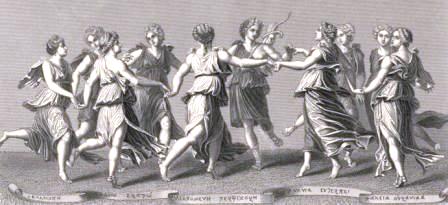Copyright ©2008 by Paul Niquette. All rights reserved.

Copyright ©2008 by Paul Niquette. All rights reserved.

Muses have been appropriated by the Romans as the nymphs of springs, by the Völva of Norse Mythology and also by the apsarasa in the culture of classical India. Popular chicks, wouldn't you say?Realms of artistic endeavors have been assigned over time to the Muses, becoming standardized during 12th century Renaissance. Muses are explicitly used in modern English to refer to their respective inspirations, and their collective spirits are also embodied in the word 'amuse'. You are invited to match the names of the following Muses to their patronages tabulated below... |
|
Calliope
Clio Erato Euterpe Melpomene Polyhymnia Terpsichore Thalia Urania Wheelia |
Amorous One) -- muse
of love or erotic
poetry
Beautiful of Speech -- muse of epic or heroic poetry Blossoming One -- muse of comedy, bucolic poetry Celestial One -- muse of astronomy Chanting One -- muse of tragedy Delights in Dance -- muse of choral song and dance Glorious One -- muse of history Pedaling One -- muse of bicycling Singer of Hymns -- muse of sacred oratory, rhetoric |